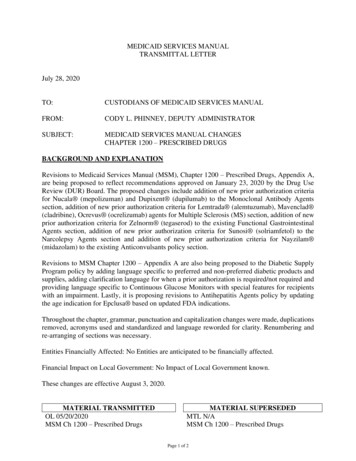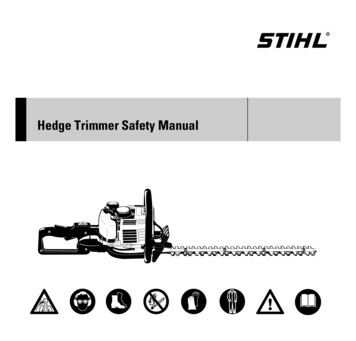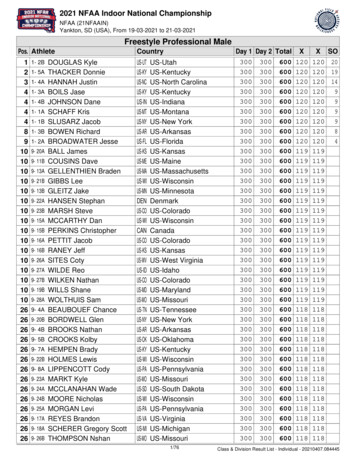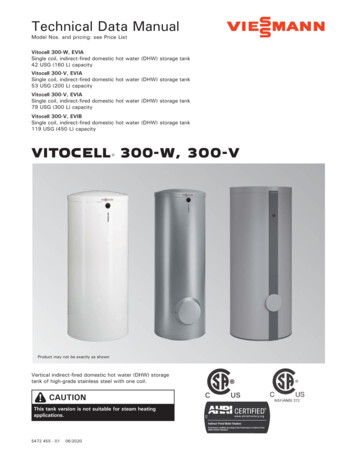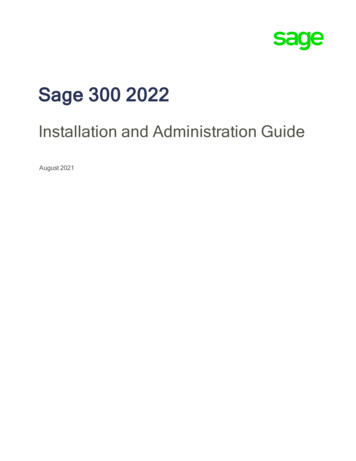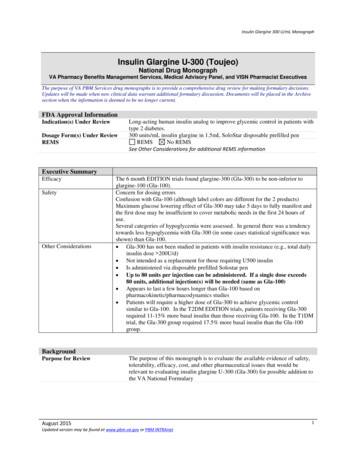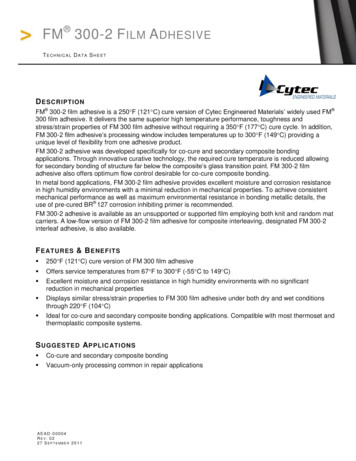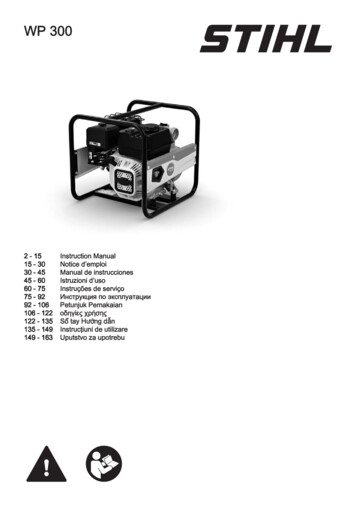
Transcription
WP 3002 - 1515 - 3030 - 4545 - 6060 - 7575 - 9292 - 106106 - 122122 - 135135 - 149149 - 163Instruction ManualNotice d’emploiManual de instruccionesIstruzioni d’usoInstruções de serviçoИнструкция по эксплуатацииPetunjuk Pemakaianοδηγίες χρήσηςSổ tay Hướng dẫnInstrucţiuni de utilizareUputstvo za upotrebu
English1IntroductionDear Customer,Thank you for choosing STIHL. We develop andmanufacture our quality products to meet ourcustomers’ requirements. The products aredesigned for reliability even under extreme con‐ditions.STIHL also stands for premium service quality.Our dealers guarantee competent advice andinstruction as well as comprehensive servicesupport.22.1Guide to Using this ManualApplicable DocumentsThis instruction manual constitutes original man‐ufacturer's instructions in the sense of EC Direc‐tive 2006/42/EC.Local safety regulations apply. In addition to this instruction manual, read,understand and keep the following documents:– Instruction manual and packaging of thehose used– Instruction manual for theSTIHL EHC 605.0/705.0 engine2.2Symbols used with warnings inthe textWARNING This symbol indicates dangers that can causeserious injuries or death. The measures indicated can avoid seriousinjuries or death.NOTICE This symbol indicates dangers that can causedamage to property. The measures indicated can avoid damageto property.2.3Symbols in the TextThis symbol indicates a chapter in thisinstruction manual.Printed on chlorine-free paperPrinting inks contain vegetable oils, paper can be recycled.89101112131415161718192021Introduction. 2Guide to Using this Manual. 2Overview. 3Safety Precautions.4Preparing Water Pump for Operation. 8Connecting to a water source. 8Refuelling the Water Pump and AddingEngine Oil. 9Starting and Stopping the Engine. 10Checking the Water Pump. 10Working with the Water Pump. 11After Finishing ance. 12Repairing.12Troubleshooting. 12Specifications.13Spare Parts and Accessories.14Disposal. 14EC Declaration of Conformity. 15Translation of Original Instruction Manual0000010020 005 GBContents1234567STIHL expressly commit themselves to a sus‐tainable and responsible handling of naturalresources. This user manual is intended to helpyou use your STIHL product safely and in anenvironmentally friendly manner over a longservice life.We thank you for your confidence in us and hopeyou will enjoy working with your STIHL product.IMPORTANT! READ BEFORE USING ANDKEEP IN A SAFE PLACE FOR REFERENCE.20478-701-9901-A ANDREAS STIHL AG & Co. KG 20220478-701-9901-A. VA2.D22.Dr. Nikolas Stihl
3 Overview33.1OverviewWater PumpEnglish12 Rear engine oil capThe engine oil cap seals the opening forchecking the oil level.13 Main switchThe main switch is used to switch on and stopthe engine.14 Suction openingThe suction opening is used to connect thesuction hose.15 Outlet openingThe outlet opening is used to connect thepressure hose.# Rating plate with machine number3.2Components for Connectingthe Hoses1 Spark plug socketThe spark plug socket connects the ignitionlead to the spark plug.2 MufflerThe muffler reduces the water pump's noiselevel.3 FrameThe frame is used to protect and transport thewater pump.4 Fuel tank capThe fuel tank cap seals the fuel tank.5 Starter handleThe starter handle is used to start the engine.6 Throttle leverThe throttle lever is used to adjust the enginespeed.7 Choke leverThe choke lever is used for starting theengine.8 Fuel cockThe fuel cock shuts off the fuel feed.9 Screw plugThe screw plug seals the opening for addingwater.10 Screw plugThe screw plug seals the opening for drainingwater.11 Front engine oil capThe engine oil cap seals the opening for add‐ing engine oil.0478-701-9901-A1 Connecting pieceThe connecting piece is used to connect ahose.2 SealThe seal seals the connecting piece.3 Union nutThe union nut secures the connecting pieceto the water pump.4 ClampThe clamp secures a hose to the connectingpiece.5 Suction strainerThe suction strainer filters the water taken in.3.3SymbolsThe symbols can be on the water pump, theengine or the oil filler neck and have the follow‐ing meaning:The fuel cock is opened andclosed by moving the lever.The choke lever must be acti‐vated when starting a coldengine.3
English4 Safety PrecautionsNote the engine oil capacity.Read, understand and keep theinstruction manual.The engine must be filled withengine oil before starting.This symbol indicates the throt‐tle lever.44.1Safety PrecautionsWarning SymbolsThe warning symbols on the water pump havethe following meaning:Follow the safety instructions and theirmeasures.Read, understand and keep theinstruction manual.Wear hearing protection.Do not breathe in exhaust fumes.Do not touch hot surfaces.Do not refuel when the engine is run‐ning or heated to a high temperature.Maintain distance from objectsand keep third parties away.4.2Intended UseThe STIHL WP 300.0 water pump is used forpumping fresh water to a maximum height of33 m and from a maximum depth of 7 m. Thewater pump may only be used as a stand-aloneunit.4The STIHL WP 300.0 water pump is not intendedfor the following applications:– Pumping petrol, oil, thinner, solvent and simi‐lar materials– Pumping acids, alkalis, bases and similarmaterials– Pumping liquid food products– Pumping salt water– Pumping water with a temperature above40 C.NOTICE Local regulations and instructions govern theextraction of water from above-ground bodiesof water. Observe and comply with local regulations.WARNING Failure to use the water pump as intendedmay result in serious or fatal injury to peopleand damage to property. Use the water pump as described in thisinstruction manual.4.3The OperatorWARNING Users without adequate training or instructioncannot recognize or assess the risks involvedin using the water pump. The user or otherpersons may sustain serious or fatal injuries. Read, understand and save theinstruction manual. If the water pump is passed on to anotherperson: Always give them the instructionmanual. Make sure the user meets the followingrequirements:– The user must be rested.– The user must be in good physical con‐dition and mental health to operate andwork with the water pump. If the user’sphysical, sensory or mental ability isrestricted, he or she may work onlyunder the supervision of or as instructedby a responsible person.– The user is able to recognize andassess the risks involved in using thewater pump.– The user must be of legal age or isbeing trained in a trade under supervi‐sion in accordance with national rulesand regulations.0478-701-9901-A
4 Safety Precautions– The user has received instruction from aSTIHL servicing dealer or other experi‐enced user before working with thewater pump for the first time.– The user must not be under the influ‐ence of alcohol, medication or drugs. If you have any queries: Contact a STIHLservicing dealer for assistance. The water pump’s ignition system produces anelectromagnetic field. This field may interferewith some pacemakers. This can result in seri‐ous or fatal injuries. If the user has a pacemaker: Make sure thepacemaker is not affected.4.4Clothing and EquipmentWARNING Long hair may be pulled into the water pumpwhen working. This may result in serious injuryto the user. Tie up long hair securely so that it is abovethe shoulders. The user may come into contact with contami‐nated water or water may spray from the waterpump or hoses when working. This may resultin injury to the user. Wear close-fitting safety glasses. Suitablesafety glasses are tested in accordancewith EN 166 or national regulations andavailable commercially with the correspond‐ing marking. Noise is produced while working. Noise maydamage the hearing. Wear hearing protection. Unsuitable clothing may get caught in thewater pump. This may result in serious injuryto the user. Wear close-fitting clothing. Remove scarves and jewellery. Wearing unsuitable footwear may cause theuser to slip. This may result in injury to theuser. Wear sturdy, closed-toed footwear withhigh-grip soles.4.5Work Area and SurroundingsWARNING Bystanders, children and animals cannot rec‐ognize or assess the dangers of the waterpump. Innocent bystanders, children and ani‐0478-701-9901-AEnglishmals may be seriously injured and damage toproperty may occur. Keep bystanders, children and animalsaway from the work area. Do not leave the water pump unattended. Make sure that children cannot play withthe water pump. Hot exhaust gas is emitted through the mufflerwhile the engine is running. Hot exhaust gascan ignite easily flammable materials andcause a fire. Keep exhaust gas well away from easilyflammable materials.4.6Safe conditionThe water pump is in a safe condition if the fol‐lowing points are observed:– The water pump is not damaged.– There is no fuel leaking from the water pump.– The fuel tank cap is closed.– The water pump is clean.– The controls function properly and have notbeen modified.– Hoses suitable for use with water pumps arefitted.– The hoses are properly fitted.– Only genuine STIHL accessories designed forthis water pump model are fitted.– The accessories are correctly attached.WARNING If not in safe condition, components may nolonger operate correctly, safety devices maybe disabled and fuel leakage may occur.There is a risk of serious or fatal injury. Work only with an undamaged water pump. If fuel is leaking from the water pump: Donot use the water pump and contact aSTIHL dealer for assistance. Close the fuel tank cap. If the water pump is dirty: Clean the waterpump. Do not modify the water pump. If the controls do not function properly: Donot use your water pump. Only fit hoses that are suitable for use withwater pumps. Only fit genuine STIHL accessoriesdesigned for this water pump model. Mount hoses and accessories as describedin this instruction manual or the instructionssupplied with the accessory. Never insert objects in the water pump’sopenings. Replace worn or damaged labels.5
English4 Safety Precautions If you have any doubts, be sure to consult aSTIHL dealer.4.7Fuel and RefuellingWARNING The fuel used for this water pump is petrol.Petrol is extremely inflammable. If petrolcomes into contact with an open flame or hotobjects, it may cause fires or explosions. Thismay result in serious or fatal injury to peopleand damage to property. Protect petrol from heat and fire. Do not spill petrol. If petrol is spilled: wipe up the petrol with acloth and do not attempt to start the engineuntil all parts of the water pump and thearea around the water pump are dry. Do not smoke. Do not refuel in the vicinity of flames. Before refuelling, stop the engine and allowit to cool. If the tank needs to be emptied: do this outof doors. Start the engine at least 3 m away from therefuelling site. Never store the water pump with petrol inthe tank inside closed rooms. Breathing in petrol fumes may result in poison‐ing. Do not breathe in petrol fumes. Refuel in a well-ventilated place. The water pump warms up while working. Thepetrol expands and overpressure may occur inthe fuel tank. Petrol may gush out when thefuel tank cap is opened. The gushing petrolmay ignite. This may result in serious injury tothe user. Allow the water pump to cool down beforeopening the fuel tank cap. Clothing that comes into contact with petrol ishighly inflammable. This may result in seriousor fatal injury to people and damage to prop‐erty. If clothing comes into contact with petrol:change clothing. Petrol poses a risk to the environment. Do not spill fuel. Dispose of petrol in accordance with regula‐tions and in an environmentally acceptableway. If petrol comes into contact with the skin oreyes, this may cause irritation. Avoid contact with petrol.6 In the event of contact with the skin: washthe affected areas with plenty of soap andwater. In the event of contact with the eyes: rinsethe eyes with plenty of water for at least 15minutes and seek medical attention. The water pump's ignition system generatessparks. Sparks may escape and cause firesand explosions in highly inflammable or explo‐sive environments. This may result in seriousor fatal injury to people and damage to prop‐erty. Use the spark plugs described in thisinstruction manual. Screw in the spark plug and tighten firmly. Press on the spark plug socket firmly. The water pump may be damaged if it is refu‐elled with petrol that is not suitable for theengine. Use fresh, good-quality unleaded petrol. Observe the specifications in the engineinstruction manual.4.8WorkingWARNING The user may lose control of the water pump ifthey do not start the engine correctly. Thismay result in serious injury to the user. Start the engine as described in this instruc‐tion manual. If the water pump is operated without thehoses attached, the user's hands may getcaught in the suction and outlet openings. Thismay result in serious injury to the user. Only operate the water pump with thehoses attached. Do not put your hands in the suction or out‐let openings. Exhaust fumes are produced when the engineis running. Breathing in exhaust fumes mayresult in poisoning. Do not breathe in exhaust fumes. Use the water pump in a well-ventilatedplace. Do not work in a well with the water pump. If nausea, headaches, vision problems,hearing problems or dizziness occur: stopworking and consult a doctor. If the user is wearing hearing protection andthe engine is running, their perception andassessment of noise may be limited. Work calmly and carefully.0478-701-9901-A
4 Safety Precautions If the water pump changes or starts to behavedifferently when working, it may not be in safecondition. This may result in serious injury topeople and damage to property. Stop working and consult a STIHL special‐ist dealer. Water can freeze on the floor and in compo‐nents of the water pump at temperaturesbelow 0 C. This may result in the user slip‐ping, falling and becoming seriously injured. Itmay also result in damage to property. Do not use the water pump at temperaturesbelow 0 C. If the suction hose or pressure hose is pulled,the water pump may move and fall over. Thismay result in damage to property. Do not pull on the suction hose or pressurehose. If the water pump is placed on a sloping,uneven or unpaved surface, it may move andfall over. This may result in damage to prop‐erty. Place the water pump on a horizontal, leveland paved surface. Secure the water pump so it cannot move. Taking in highly inflammable and explosive liq‐uids may cause fires and explosions. This mayresult in serious or fatal injury to people anddamage to property. Do not take in or discharge highly inflam‐mable or explosive liquids. Taking in irritating, corrosive and toxic liquidsmay endanger health and damage compo‐nents of the water pump. This may result inserious or fatal injury to people and damage toproperty. Do not take in or discharge irritating, corro‐sive or toxic liquids. The water pump is not sterile or food-safe. Ifliquid food products are taken in, they will becontaminated. Do not take in or discharge liquid food prod‐ucts. If the water pump is not filled with water beforestarting the engine, this may result in damageto the water pump. Fill the water pump with water before start‐ing the engine. If the suction strainer is not attached, objectsmay be sucked into the water pump. Thewater pump may become clogged or dam‐aged. Attach the suction strainer. The engine of the water pump is not water‐proof. If the water pump is placed in water, theengine may be damaged.0478-701-9901-AEnglish Operate the water pump on a dry surface. Badly routed hoses may become damagedand people may trip over them. This mayresult in injury to people and damage to thehoses. Route and mark the hoses so people can‐not trip over them. Route the hoses so they are not stretchedor tangled. Route the hoses so they do not becomedamaged, kinked or crushed or chafe. Protect the hoses from heat, oil and chemi‐cals. If people sit or stand on the water pump, theymay come into contact with hot componentsand be seriously injured. If objects are placedon the water pump, they may fall down andcause serious injury to people. Do not sit or stand on the water pump. Do not place any objects on the waterpump.4.9TransportingWARNING The water pump may tip over or move duringtransport. This may result in injury to peopleand damage to property. Stop the engine. Secure the water pump with lashing straps,belts or a net so it cannot tip over andmove. The muffler and engine may be hot after theengine has been running. This may result inthe user burning themselves. Carry the water pump by the frame with themuffler pointing away from the body. Water can freeze in components of the waterpump at temperatures below 0 C. This mayresult in damage to the water pump. Drain the water pump.4.10StoringWARNING Children are not aware of and cannot assessthe dangers of a water pump and can be seri‐ously injured. Shut off the engine. Store the water pump out of the reach ofchildren. Dampness can corrode the electrical contactson the water pump and metal components.This can damage the water pump. Store your water pump in a clean and drycondition.7
English5 Preparing Water Pump for Operation Water can freeze in water pump componentsat temperatures below 0 C. This can damagethe water pump. Drain the water pump.4.11Cleaning, Maintenance andRepairWARNING The water pump may inadvertently start if theengine is running during cleaning, mainte‐nance or repair. This may result in seriousinjury to people and damage to property. Stop the engine. The muffler and engine may be hot after theengine has been running. This may result inpeople burning themselves. Wait until the muffler and engine havecooled down. Abrasive cleaning agents or using a water jetor sharp objects for cleaning may result indamage to the water pump or hoses. If thewater pump or hoses are not cleaned cor‐rectly, components may no longer operate cor‐rectly and safety devices may be disabled.This may result in serious injury to people. Clean the water pump as described in thisinstruction manual. Clean the hoses as described in thisinstruction manual. If the water pump or hoses are not maintainedor repaired as described in this instructionmanual, components may no longer operatecorrectly and safety devices may be disabled.This may result in serious or fatal injury topeople. Maintain or repair the water pump asdescribed in this instruction manual. Maintain hoses as described in the instruc‐tion manual for the hoses used.5Preparing Water Pump forOperation5.1Preparing the Water Pump forOperationThe following steps must be performed beforecommencing work: Remove packaging material and transportlocks. Make sure that the water pump is in safe con‐dition,4.6. Clean the water pump,14.1.8 Connect the water pump to a water source,6.1. Fill the water pump housing with water,6.2. Refuel the water pump,7.1. Add engine oil,7.2. Check the controls,9.1. If the steps cannot be performed: do not usethe water pump and consult a STIHL specialistdealer.66.1Connecting to a watersourceConnecting the Water Pump toa Water SourceThe water pump can take in water from rain bar‐rels, cisterns and from flowing or standing water.In order for the water to be taken in, the differ‐ence in height between the water pump and thewater source must not exceed the maximum suc‐18.1.tion head (a),The suction hose must be inherently stable toprevent collapse in the event of negative pres‐sure.The suction strainer must be used.Attaching the hose connections Stop the engine. Screw on union nut (1) together with connect‐ing piece (2) and seal (3). Do this at bothopenings.0478-701-9901-A
7 Refuelling the Water Pump and Adding Engine OilEnglishAttaching the hosesWARNING Do not disconnect the water pump from thewater source during operation and allow it torun empty.Operating the water pump without the housingcompletely filled can cause severe damage tothe pump.6.2 Push clamps (1) onto pressure hose (2) andsuction hose (3). Push pressure hose (2) over connectingpiece (4). Push suction hose (3) over connectingpiece (5). Align clamps (1) centrally over the resistanceribs of connecting pieces (2 and 3). Tighten the screws of clamps (1) firmly.Pressure hose (4) and suction hose (5) arefirmly connected to the water pump. Place upper part of suction strainer (6) onlower part of suction strainer (7) and turn itanti-clockwise until markings (8) on upperpart (6) and lower part (7) are in line.Upper part (6) and lower part (7) of the suctionstrainer are firmly connected to each other. Push clamp (9) onto the other end of suctionhose (5). Push this end of suction hose (5) over the con‐necting piece of suction strainer (10). Align clamp (9) centrally on the connectingpiece of suction strainer (10). Tighten the screw of clamp (10) firmly.Suction strainer (10) is firmly connected tosuction hose (5). Suspend suction strainer (10) in the watersource so that it does not touch the bottom.Filling the Water Pump Hous‐ing with WaterNOTICE The water pump housing does not contain anywater on delivery. In order for water to betaken in and pumped through the hoses, thewater pump must be filled with water. Startingthe engine with no or too little water in thewater pump housing may damage the waterpump. Add water to the water pump housingbefore starting the pump. Turn screw plug (1) anti-clockwise until it canbe removed. Fill the water pump housing with at least2 litres of water. Replace screw plug (1). Turn screw plug (1) clockwise and tightenfirmly by hand.77.1Refuelling the Water Pumpand Adding Engine OilRefuelling the Water PumpNOTICE The water pump may be damaged if the cor‐rect fuel is not used. See the engine instruction manual. Stop the engine. Place the water pump on a flat surface withthe fuel tank cap facing up.0478-701-9901-A9
English8 Starting and Stopping the Engine Clean the area around the fuel tank cap with adamp cloth. Turn fuel tank cap (1) anti-clockwise until itcan be removed. Remove fuel tank cap (1). Add fuel without spilling any and stop at least15 mm short of the fuel tank brim. Place fuel tank cap (1) on the fuel tank. Turn fuel tank cap (1) clockwise and tightenfirmly by hand.The fuel tank is sealed.7.2Adding Engine OilThe engine oil lubricates and cools the engine.The engine oil specification and capacity can befound in the engine instruction manual. Turn main switch (1) to . Push fuel cock (2) in the direction of the arrow. Push choke lever (3) in the direction of thearrow. Push throttle lever (4) in the direction of thearrow. Press the water pump to the ground with theleft hand on upper frame (1) and place theright foot on lower frame (2). Slowly pull out starter handle (3) with the righthand to the point of noticeable resistance. Keep quickly pulling out and returning starterhandle (3) until the engine is running. Push the choke lever back so the engine doesnot stall.8.2Stopping the EngineNOTICE The water pump does not contain any engineoil on delivery. Starting the engine with no ortoo little engine oil may damage the waterpump. Always check the engine oil level beforestarting and if necessary top up. Add the engine oil as described in the engineinstruction manual.88.1Starting and Stopping theEngineStarting the Engine Place the water pump on a level surface.10 Turn main switch (1) to 0.The engine stops.99.1Checking the Water PumpChecking the Controls Start the engine. Turn the main switch to 0.The engine stops.0478-701-9901-A
10 Working with the Water Pump If the engine does not cut out: Close the fuel cock and do not use thewater pump; consult a STIHL dealer.The main switch is defective.10Working with the WaterPump10.1Securing the Water Pump10.2Routing the Suction HoseEnglishSand and dirt are flushed out of the waterpump and hoses. Stop the engine. Allow the water pump to cool down. Secure the water pump so it cannot move.To prevent excessive strain on the threaded con‐nection of the suction opening and to prevent theseal from being crushed or moved, place a suita‐ble object under the suction hose. Place a suitable object (1) under suctionhose (2) so that it runs as straight as possibleand has no kinks.10.3Operating the Pump Unscrew union nuts (1).The hoses are detached. Turn screw plug (2) anti-clockwise until it canbe removed.Water flows out of the water pump. Tilt the water pump forwards to drain it com‐pletely. Replace screw plug (2). Turn screw plug (2) clockwise and tightenfirmly by hand. If the water pump is wet: allow the water pumpto dry. Clean the water pump.1212.1TransportingTransporting the Water Pump Stop the engine.Carrying the water pump Carry the water pump by the frame with themuffler pointing away from the body.Transporting the water pump in a vehicle Secure the water pump in an upright positionso it cannot tip over or move.13The pump delivery rate can be adjusted by mov‐ing the throttle lever. Move the throttle lever to position : the pumpdelivery rate decreases. Move the throttle lever to position : the pumpdelivery rate increases.11After Finishing Work11.1After Finishing Work Connect the water pump to a water source insuch a way that no sand or dirt can be takenin. Start the engine.0478-701-9901-A13.1StoringStoring the Water Pump Stop the engine. Store the water pump in accordance with thefollowing conditions:– The water pump is out of reach of children.– The water pump is clean and dry.– The storage temperature is -20 C to 60 C. If the water pump is to be stored for more than30 days: Open the fuel tank cap. Drain the fuel tank. Seal the fuel tank.11
English1414.114 CleaningCleaning14.3Cleaning the Water Pump Shut off the engine. Allow water pump to cool down. Clean the water pump with a damp cloth orSTIHL resin solvent. Clean cooling air slots with a soft brush.14.2Cleaning the Hoses Shut off the engine. Clean the hoses with a damp cloth. Rinse the hoses with water.1515.1MaintenanceMaintenance IntervalsMaintenance intervals are dependent on theambient conditions and the working conditions.STIHL recommends the following maintenanceintervals:Cleaning the Suction Strainer Stop the engine. Rinse the suction strainer under runningwater.Engine Maintain the engine as described in the engineinstruction manual.Water pump Have the water pump inspected annually by aSTIHL specialist dealer.1616.1 For coarser soiling, detach lower part of suc‐tion strainer (1) from upper part of suctionstrainer (2) by turning it anti-clockwise andremove. Rinse the inside of the suctionstrainer under running water.1717.1RepairingRepairing the Water PumpThe water pump cannot be repaired by the user. If the water pump is damaged: Do not useyour water pump and contact your STIHLservicing dealer for assistance.TroubleshootingRemedying Water Pump FaultsFaultEngine cannot bestarted.CauseInsufficient fuel in fueltank.Carburettor overheat‐ing.Carburettor iced up.Main switch set toposition 0.Inferior, dirty or oldfuel in tank.Remedy Refuel water pump. Allow water pump to cool down. Allow water pump to warm up. Press main switch. Use fresh, good quality fuel (unleaded petrol).Clean carburettor.Clean fuel line.Clean or replace spark plug.Check connection between ignition lead and plug.Spark plug socket isdetached from sparkplug or ignition lead isnot properly fastenedto socket.Spark plug is dirty, Clean or replace spark plug.damaged or elec‐ Adjust electrode gap.trode gap is incorrect.Engine flooded. Remove spark plug and dry; set main switch to 0 andpull starter rope repeatedly with spark plug removed.Air filter dirty. Clean or replace air filter.Oil level in engine too Add engine oil.low.120478-701-9901-A
18 SpecificationsFaultEngine difficult tostart or engine powerdeteriorating.Engine overheating.Engine runningroughly.EnglishCauseWater in fuel tankand carburettor orcarburettor isblocked.Fuel tank contamina‐ted.Spark plug dirty.Incorrect fuel used.Air filter dirty.Cooling ribs dirty.Incorrect fuel used.Insufficient fuel in fueltank.Air filter dirty.Engine stops during Oil level in engine isoperation.too low and oil pres‐sure sensor stopsengine.Insufficient fuel in fueltank.Heavy smoke forma‐ Oil level in engine istion.too high.Air filter dirty.Excessive vibrationVibration dampersduring operation.worn.Water pump notSuction strainer orpumping water.hoses are clogged.Insufficient water.No water in waterpump.Maximum deliveryhead or maximumsuction head hasbeen exceeded.Suction hose col‐lapsed on itself.Suction hose leakingor not medy Empty fuel tank, clean fuel line and carburettor. Clean fuel tank. Clean or replace spark plug.Check fuel.Clean or replace air filter.Clean cooling ribs.Check fuel. Refuel water pump. Clean or replace air filter. Top up engine oil. Refuel water pump. Drain engine oil. Clean or replace air filter. Replace vibration dampers. Clean suction strainer and hoses. Ensure that a sufficient amount of water is available.Connect water pump to a water source.Fill wa
# Rating plate with machine number 3.2 Components for Connecting the Hoses 1 Connecting piece The connecting piece is used to connect a hose. 2 Seal The seal seals the connecting piece. 3 Union nut The union nut secures the connecting piece to the water pump. 4 Clamp The clamp secures a hose to the connecting piece. 5 Suction strainer

